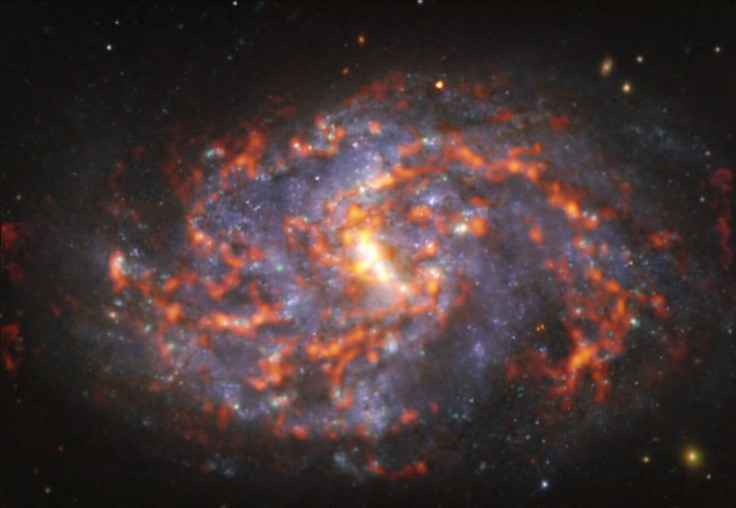Thanks to the Chile-based Atacama Large Millimeter/submillimeter Array (ALMA), astronomers are able to image the NGC 1087, which resembles a curled sleeping snake. Located about 80 million light-years from Earth, this spiral galaxy in the constellation Cetus was recorded by a combination of observations made at different wavelengths of light, according to the European Southern Observatory's (ESO) statement.
Just to be clear, the NGC 1087 is not poisonous.

What Information Is Contained in the Image?
ESO said that the ominous red hue is actually clouds of cold molecular gas, the raw material from which stars are formed. Meanwhile, the bluish spots in the background depict a pattern of older, already developed stars, as photographed by ESO's Very Large Telescope (VLT) in Chile's Multi-Unit Spectroscopic Explorer (MUSE).
The photos were collected as part of the PHANGS project, which stands for Physics at High Angular Resolution in Nearby Galaxies. With telescopes operating across a wide range of wavelengths, the team is making high-resolution observations of neighboring galaxies.
Other Heavenly Bodies Observed by ALMA
ALMA has captured a number of celestial bodies in the past. In fact, it has photographed many galaxies and other incredible places in space.
One of these is a comet named C/2014 UN271, which is a massive comet that will likely have its closest approach to Earth in 2031. The comet, also known as comet Bernardinelli-Bernstein, is 85 miles (137 kilometers) in diameter and originates from the Oort Cloud.
According to the most recent data, this comet is the largest Oort Cloud object yet discovered. The Oort Cloud is hypothesized to be the source of comets that we usually observe in the skies.
However, this comet will not be visible to the human eye as it passes within a few million miles of Saturn. Astronomers, on the other hand, will be keeping a close eye on it because it appears to be quite exceptional. The ALMA telescope was utilized to examine the comet's size and reflectivity, or albedo. Click here to learn more.
Read More : ALMA Scientists Find Signs of Water in Faraway Galaxy, Could This Signal Life Away From Earth?
Another celestial body that ALMA has captured is what the researchers believe to be the farthest astronomical object ever detected. A galaxy known as HD1 has been labeled not only the most distant galaxy but also the universe's new farthest object, having been discovered around 330 million years after the Big Bang and at a distance of 13.5 billion light-years.
The most distant galaxy ever discovered was observed in the early Universe as a bright red object. Dubbed HD1 by the discoverers, it is estimated to be 13.5 billion light-years away, or 100 million light-years farther than the existing farthest galaxy, GN-z11.
Using the Subaru Telescope, VISTA Telescope, United Kingdom Infrared Telescope (UKIRT), and Spitzer Space Telescope, astronomers discovered HD1 after 1,200 hours of observation. To confirm the distance, the ALMA was utilized. To confirm its initial calculations, the scientists will use NASA's powerful James Webb Space Telescope to observe HD1.
For more information, go here.









